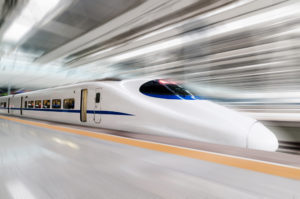It’s no longer news that industrial policy is making a comeback. Too bad, that. In the zombie parade of bad policies that the left and the new right are now staging, this one is particularly baffling. Industrial policy has been tried on large scales – think the Soviet Union – and on smaller scales, including in the US and many other countries.
The fact that past industrial policy attempts were abandoned due to grotesque failure to achieve their goals seems to make no difference to those who are intent on reviving this practice. Indeed, we need not look as far back as the 1980s for evidence of the folly of trusting government to guide industrial development; we have a contemporary example. And this example is detailed by none other than the New York Times, which recently reported that, after years and billions of dollars, California’s effort to build a high-speed train has been a disaster. A tidbit:
This effort qualifies as industrial policy because the government claims to know better than private markets what is the best means of transportation and worth high-jacking resources to produce bureaucrats’ preferred outcome. But as usual, government officials – spending other people’s money – miss the obvious.
There’s a reason why trains in the U.S. trains are far less popular than planes. There’s a reason why travel by rail make more sense in small countries, and along the densely populated northeastern coast of the U.S. But politicians and intellectuals, enamored of the notion that trains are more friendly to the planet than are planes, ignore these realities in pushing for an industrial outcome that will likely never be profitable. For a walk down failed-rail-project memory lane see this piece by Phil Klein.

Building a high-speed rail connecting Los Angeles and San Francisco was always going to be challenging due to California’s geography. And of course, most of you will not be surprised to learn that this large-scale government project is in fact failing, in large part because of the perverse incentives that pervade such a government project. From conception to planning to building, the incentives consistently encourage waste and error. Again, legislators aren’t funding this boondoggle with their own money. Nor will they be personally accountable for cost overruns, failure to deliver, or what are certain to be many technical problems.
The cost overruns here are almost comical for something that literally hasn’t been built yet. In 2008, the train’s cost was projected to be $33 billion. Fourteen years later the final plan is projected to cost $113 billion – a mere 242 percent more than the sum used to peddle the scheme to the general public.
In addition, decisions on construction are unduly – but not unsurprisingly – influenced by special interests rather than by good economic sense. As the Times writes: “political deals created serious obstacles in the project from the beginning.” Here’s more:
As if the project wasn’t difficult enough to deliver on, legislators decided to create costly detours to serve political friends:
Political compromises, the records show, produced difficult and costly routes through the state’s farm belt. They routed the train across a geologically complex mountain pass in the Bay Area. And they dictated that construction would begin in the center of the state, in the agricultural heartland, not at either of the urban ends where tens of millions of potential riders live….
Mike Antonovich, a powerful member of the Los Angeles County Board of Supervisors, was among those who argued that the train could get more riders if it diverted through the growing desert communities of Lancaster and Palmdale in his district, north of Los Angeles.
Even the SNCF engineers from France who came to work on the project eventually gave up:
Morocco’s bullet train has been in service since 2018.
The report is worth reading in its entirety. It is the most ridiculous and clichéd story of why industrial policy fails. Such projects are often taken over by special interest groups (remember Alaska’s bridge to nowhere) that bloat the cost, and in extreme cases lead the project to failure.
This experience is commonplace. My colleague Jack Salmon told me about the plans for HS2, a high-speed rail project in the U.K., that started in 2009 to link London to Birmingham, Manchester, and Leeds. The high-speed train was promised to reduce the time of the journey by 30 minutes. Salmon sent me the following information:
That’s the problem with industrial policy, and such gravy train projects. Politicians can’t help themselves and these projects are always highjacked by special interests.
Veronique de Rugy is a Senior research fellow at the Mercatus Center and syndicated columnist at Creators.


READER COMMENTS
Jon Murphy
Oct 20 2022 at 5:25pm
Today, I want to a place where many proponents of industrial policy claim it was victorious: US wartime production during World War 2. Specifically, I was at Oak Ridge, the specially-built town/military installation in Tennessee where they developed and enriched uranium for the atomic bomb.
I will say, the scope and scale of such an operation was awesome (and I mean that in the usual sense of: “extremely impressive or daunting; inspiring great admiration, apprehension, or fear.”). But every aspect of these people’s lives were controlled. They were constantly spied upon. It was insane. Not something a liberal-minded person would want to live under constantly.
Now, of course, one can reasonably argue that such security was necessary because of war. But yet, much of the industrial planning rhetoric relies on the idea that we are at war, specifically with China. One full-throated defender of industrial planning I saw declared that trade with China “destroyed US factories more effectively than any missile.”* So, returning to war-planning is part and parcel for at least some of these folks.
But, security issues aside, yes the US industrial planning of World War 2 was amazing. Mind blowing. But it did not produce prosperity. Shortages were everywhere. It was not a good time, economically.
*Truly an odd statement given US manufacturing output has risen, and continues to rise, even as we have traded with China. Destruction usually results in lower, not higher, levels of output.
Mactoul
Oct 21 2022 at 1:31am
But then how to account for apparent success of state policy like giant high speed rail network of China, high speed railway elsewhere in the world, nuclear energy in France. Many such examples can be given. You can’t counter with tales of political dysfunction in US.
Jon Murphy
Oct 21 2022 at 9:35am
Not all that glitters is gold. Potemkin villages look impressive but there’s nothing to them. China’s high speed rail is exactly that.
Additionally, the point of political dysfunction is essential. We’re dealing with the United States and its structures. A dictatorship will always have less of some kinds of dysfunction than a democracy (but significantly more of other kinds)
Henri Hein
Oct 21 2022 at 2:57pm
I don’t think it’s fair to compare China’s high speed rail to Potemkin villages. A Potemkin village is purely for show and has no function. China’s high speed rail system does work at transporting people around. People that have used it, including myself and many of my Chinese friends that use it regularly, can testify that it does pretty well. The Chinese don’t have the same disposable income that Americans do. Many, even in the middle class, can not afford to fly between cities (say, for the holidays), but can afford the train. So the train system is successful in that it allows for trips that would not otherwise occur.
That’s not to dispute the larger point. I don’t think it’s valid to point to an occasional government program (industrial or otherwise) that does reasonably well to conclude they work in general. It would be like a teacher that teaches reading by handing out books and letting the kids figure it out for themselves. Sure, sometimes a student picks it up and becomes a voracious reader. That doesn’t mean the teacher hit on a good method.
Mark Brophy
Oct 21 2022 at 10:31am
France recently shut down most of their nuclear plants even though there’s an energy shortage in Europe.
Monte
Oct 21 2022 at 11:50am
Are you referring to this “success of state policy” project?
Weak Demand for China’s High-Speed Trains: A Ticking Time Bomb?
Mactoul
Oct 21 2022 at 9:39pm
Your point is correct. Failure of industrial policy is not that it fails to build something but that what is built is not economical.
Govt can always build this or that. But satisfying the real wants of individuals in proportional manner is beyond it.
Dylan
Oct 21 2022 at 8:01am
Is that true? Was the project in Morocco you reference a private project? A quick search shows this project in my backyard that reportedly came in $100m under budget. And, it’s well known now that infrastructure projects in the rest of the world all come in substantially cheaper than they do here. So, there does seem to be something uniquely dysfunctional about how we do big projects here, but I don’t know enough to know what that is.
Mark Brophy
Oct 21 2022 at 10:34am
California is the biggest state in a big country where the citizens are disconnected from the government. The more people a government rules over, the more corrupt it is due to lack of citizen oversight.
Thomas Lee Hutcheson
Oct 21 2022 at 12:19pm
A large public investment that does not pass a cost benefit analysis is worth denouncing (or even better understanding how and why the mistake was made), but “industrial policy” is something more subtle and potentially much worse. Confounding the two does not help the debate
Jon Murphy
Oct 22 2022 at 12:47pm
She is not confounding the two. She is using the rail as an example of why industrial policy fails.
Mactoul
Oct 22 2022 at 11:00pm
Won’t an industrial policy inevitable in cases where property rights are new — eg property rights in mobile spectrum, offshore leases for oil, gas and wind power.
It is the state action that creates property rights where none existed.
Jon Murphy
Oct 23 2022 at 12:14am
That wouldn’t be industrial policy.
Comments are closed.